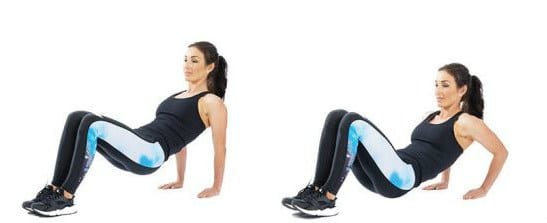One of the most effective ways to lose weight and body fat is to include, in your training sessions, exercises that recruit the main muscle groups, such as quadriceps, twins, pectorals, abdominals, etc. This type of exercises they are mostly simple and practical, adaptable to any space and do not require the use of any specialized equipment. In this way, it is possible to train at home to lose weight and fat, choosing the right exercises and combining them in short but intense circuit training, in order to speed up your heart rate as much as possible.
In fact, each exercise – from push-ups to squats – ends up recruiting several of these muscle groups at the same time, making it a “full body” exercise – a great advantage when you don’t have a lot of time to train. So, the best strategy for working with all major muscle groups is to combine at least three full-body exercises, two to three times a week, to keep your body strong, toned, flexible and healthy.
Building a balanced and proportional body is very important, both in terms of aesthetics and in terms of health, and, for this, it is essential to work all major muscle groups. The list of exercises, which you can choose to help you lose weight and build a harmonious and healthy body, is extensive. In this article we are going to suggest the seven most effective exercises and explain step by step their execution.
Exercises to lose weight at home
1. Jumping Squat or Squat With Jump
While normal air squats or squats are great for speeding up your heart rate, jumping squats or jumping squats are the most efficient alternative and definitely help you work your quadriceps more and burn more calories.
Execution:
1. From the full extension position, with your feet shoulder-width apart and with your arms at your sides, start by doing a normal squat, in which your knees bend and your hips are thrown back and down until you pass below the knee line; try not to let your shoulders pass in front of your knees and keep your upper body high to protect your back;
2. Stop in this position, activate the core muscles and jump explosively vertically, so that your feet detach from the floor; make sure you fully support your feet to jump and not just the tips;
3. As soon as you land again with your feet on the ground, lower your body back to the squat position to start a new repetition; try to land as quietly as possible to ensure that you control all movement from start to finish.
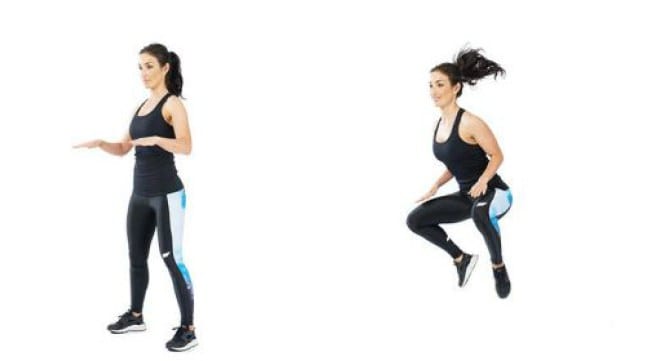
2. Side Plank or Side Plank
The side plank is a very effective exercise to build strong abs and burn fat. Few exercises are as good for the core as the side board, but it is often devalued in relation to the normal board, performed in the ventral position and with the support of the forearms on the floor. The side plank is also ideal for working a muscle, usually neglected and weak, called the lumbar square, which is part of the posterior abdominal wall and which plays a very important role in preventing back pain.
Execution:
1. It starts lying on the floor, on the right side of the body, with the feet together and overlapping, the right forearm resting on the floor, immediately under the shoulder, and the palm facing downwards;
2. Make sure you are supporting the side of the foot and not the plant, as it is essential to prolong stability;
3. Contract your abdominal muscles and raise your hips off the floor, so that your body is aligned from head to toe; maintains this position, without letting the hip drop, throughout the execution time;
4. Recruit your abdominal muscles throughout the exercise to keep your body in a straight and stable position;
5. Always keep your head aligned with your back, not letting it fall;
6. Try to hold on as long as you can; any time over 1 minute is very good;
7. In the end, switch sides and repeat.
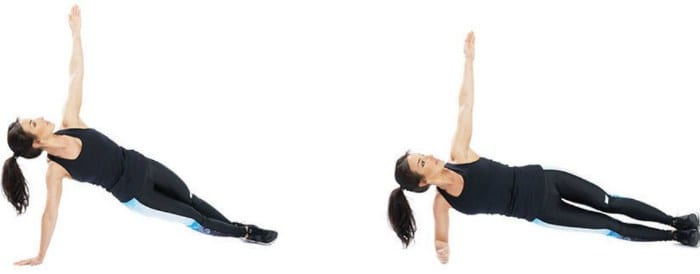
3. Burpees
Burpees are an exercise with some complexity, as they recruit the entire body and involve strength, cardiovascular capacity, balance and coordination. However, they are incredibly practical to perform, as they require no equipment and can be done anywhere.
Execution:
1. Stand up straight, with your body fully extended, with your feet shoulder width apart and your arms at your sides;
2. Start by bending your knees and extending your hands towards the floor to support them;
3. Throw your legs back so that they are stretched, keeping your body in a plank position and immediately let yourself fall to the ground in a controlled way, bending your elbows and keeping them close to your torso;
4. As soon as the body touches the ground, use your arms to quickly push you upwards, while pulling your legs towards your chest and resting your feet on the floor again, with your knees still bent;
5. Once you have your feet supported, take your hands off the floor and jump vertically towards the ceiling, fully extending your arms above your head; land with your knees already slightly bent so that you can start the next repetition immediately.
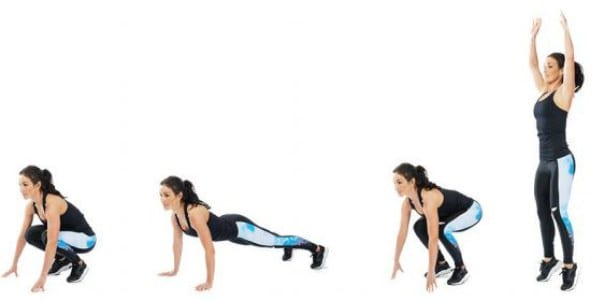
4. Jumping Lunges or Lunges With Jump
When thinking about effective exercises to work the lower body, lunges occur immediately. If you add a little jump, you will get an optimal plyometric movement to strengthen your leg muscles and to burn calories.
Movement
1. Stand with feet hip-width apart and arms at your sides;
2. He does a lunge, advancing his right foot and flexing his legs until his left knee touches the ground.
3. Ensures that both legs are bent 90 degrees;
4. From this position, jump vertically and change the position of the legs, projecting the left leg forward and the right leg backwards; lands softly, with the left foot in front and ensures that the right knee touches the ground without impact
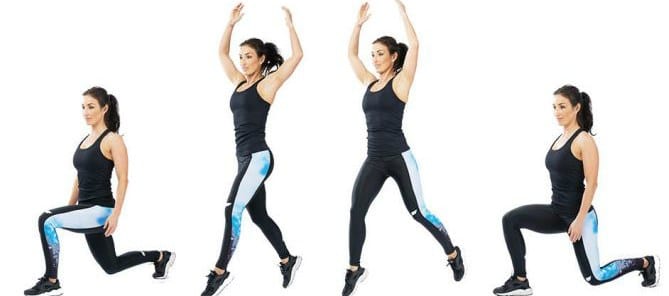
5. Butterfly Sit Ups or Lower Abs
Sit-ups are a multimuscular exercise and ideal for working the lower abdominal muscles. Although they do not specifically target visceral / abdominal fat, sit-ups exercise the abdominal muscles and other muscle groups, including the pectorals, thigh flexors, lumbar and neck muscles.
Execution:
1. Lie on your back on the floor;
2. Bend your legs and place the soles of your feet together, with the outside of your feet resting on the floor;
3. Stretch your arms behind your head so that your hands touch the ground;
4. Contract your abs and start rolling your upper body until your shoulders pass the knee line;
5. Use your arms to gain momentum on the way up and, in the final position, touch your hands on the floor in front of your feet;
6. Exhale when you go up and inhale when you return to the starting position.
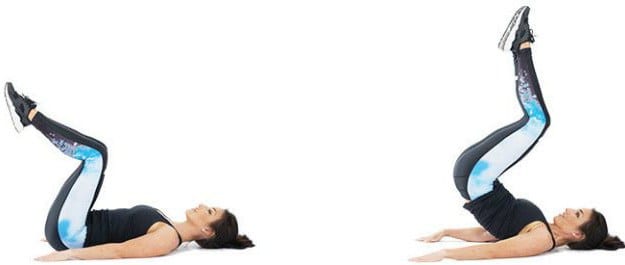
6. Lateral Crunches or Lateral Abdominals
The lateral crunches, or lateral abdominals, are a great exercise to work the abdominal muscles, with a special focus on the oblique muscles. It is a high-intensity exercise that recruits and strengthens the core, while helping to burn calories.
Execution:
1. Lie on the floor, on the right side of your body, with your legs overlapping, your knees bent at 90º and the side of your foot resting on the floor;
2. Place your right hand behind your head and your left on your chest;
3. It contracts the abdominal muscles, to help lift the torso, head and shoulders off the floor, laterally compressing the ribs towards the hip that is not supported;
4. At the same time, lift your bent legs off the floor, closing the angle between your thighs and torso, so that you can touch your knees with your right elbow;
5. Hold this position for 1 or 2 seconds and then return to the starting position, controlling the descent movement;
6. Repeat the same exercise on the left.
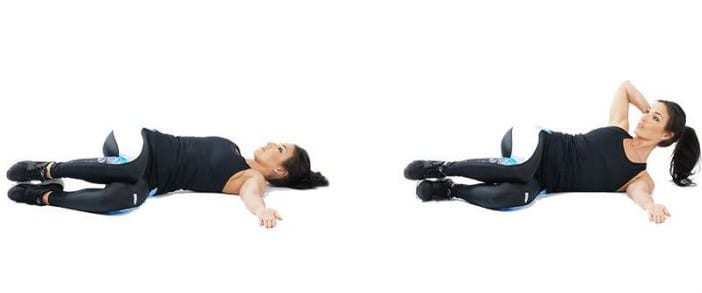
7. Dips or Sinks
Dips or dips are an exercise that, using triceps and only body weight, allows you to increase the strength of your arms and shoulders. This exercise is very simple and can be done anywhere, with just a chair, a bench or a stable step handy.
Execution:
1. Sit on the edge of a chair and support your hands on the sides, right next to your hips, with your fingers pointing forward;
2. Keep your legs completely straight, with your heels flat on the floor, and your feet hip-width apart;
3. Use your hands on the chair to raise your hips slightly, and slide forward just enough so that the back of your body moves a few inches away from the edge of the chair;
4. Start to descend vertically, towards the ground, until your arms bend 90 degrees or more;
5. At this point, stop and start to slowly push yourself up, recovering your starting position, with your arms fully stretched;
6. Controls movement across the entire range, whether descending or ascending.

